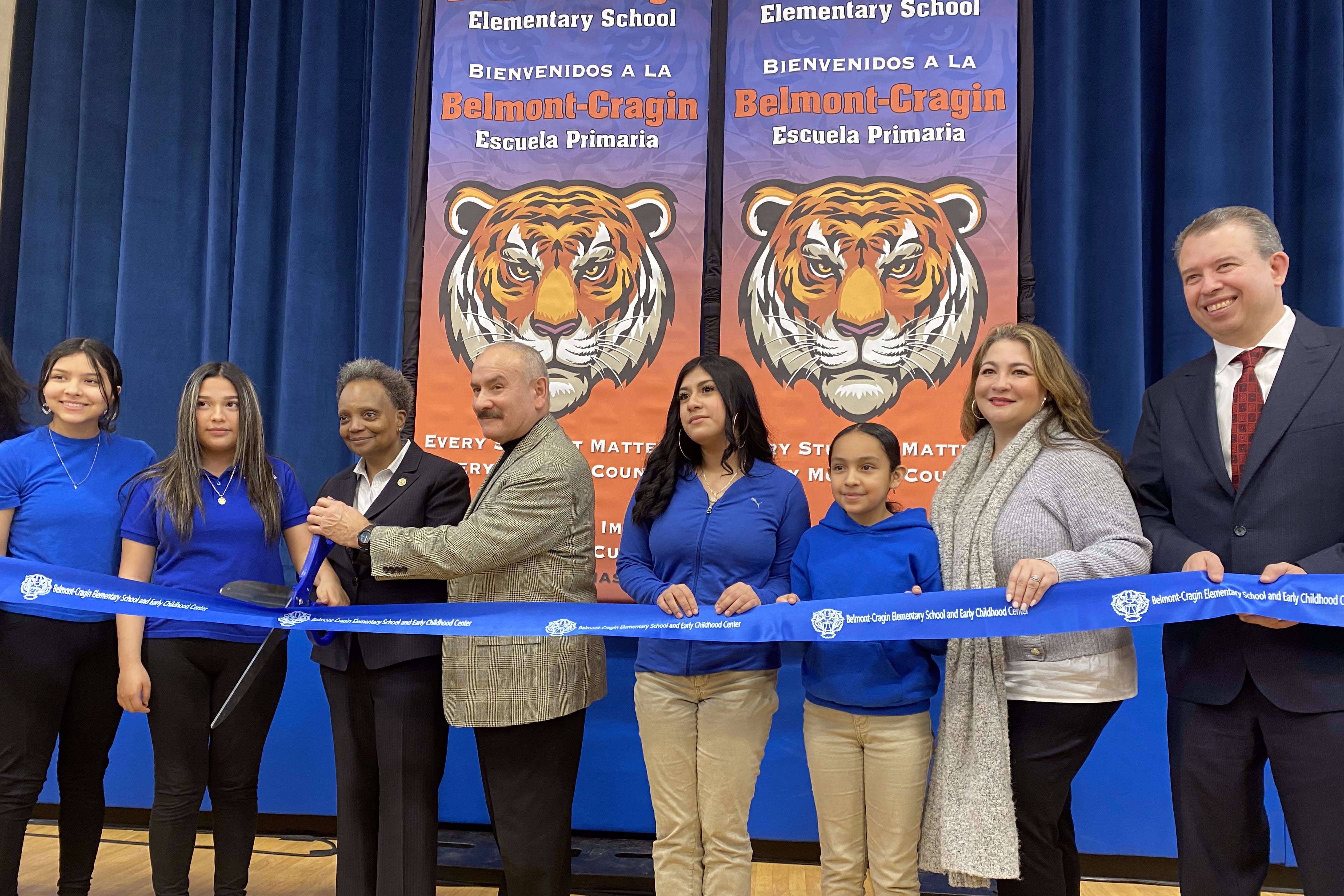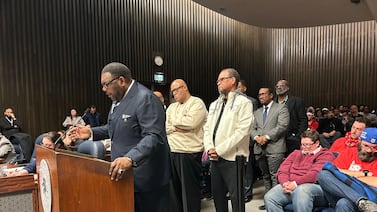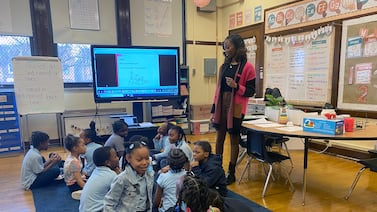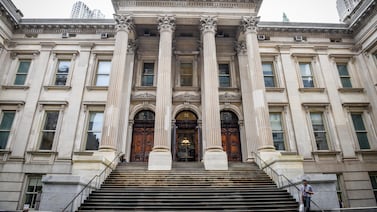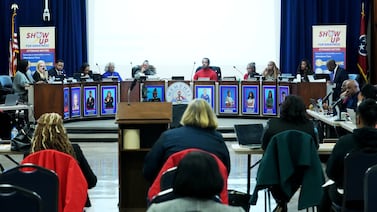Chicago Mayor Lori Lightfoot stood on a freshly-installed rubber wood floor in the gymnasium of the new Belmont-Cragin Elementary and delivered a long list of “thank-you’s” from behind a podium emblazoned with the seal of the City of Chicago.
“I can still smell the freshness and newness of this building,” Lightfoot said before using oversized scissors to cut a blue fabric ribbon at the Jan. 17 opening of the new $44 million school, a project set in motion by her predecessor Rahm Emanuel.
It is one of dozens of ribbon cuttings the incumbent mayor is doing in the weeks before the Feb. 28 election in which voters decide if she gets a second term. Lightfoot is facing eight challengers, some with strong ties to the city’s public schools, including former Chicago Public Schools CEO Paul Vallas and former teacher and current teachers union organizer Brandon Johnson.
“Our job is to come, like the calvary, to the rescue with those resources so we can help you fulfill your dreams and aspirations,” Lightfoot said at the Belmont-Cragin ribbon-cutting, where she was flanked by students, teachers, and other politicians. “This new building is absolutely what that is about.”
Since 1995, Chicago’s mayor has had control over the city’s public schools — deciding where and when to construct or repair school facilities, appointing school board members and a CEO, and negotiating contracts with the teachers union.
Lightfoot could be the last mayor — or one of the last — to wield this kind of power over education in Chicago as the city begins to transition to an elected school board in 2024.
“This is a pivotal or critical time for schools,” said Dick Simpson, a longtime observer and fixture in Chicago politics and retired professor of political science at the University of Illinois Chicago. “It’s also a critical time overall in Chicago’s history.”
Unlike her predecessors, Lightfoot did not come into office four years ago promising big changes at Chicago Public Schools. She kept existing leadership in place and continued implementing outgoing Mayor Rahm Emanuel’s plan for universal pre-K for 4-year-olds. The one promise Lightfoot did make – to support an elected school board – shifted once she was in office.
Ald. Scott Waguespack, an ally of the mayor, said Lightfoot deserves credit for leading the school system through a once in a generation pandemic.
“Navigating that was something that was done partially on the fly, but also had a good set of directives that we had to stick to to make sure that the institutions survived, including CPS,” Waguespack said.
But what has Lightfoot done so far when it comes to education and what will she do with another four years?
Lightfoot prioritizes city money for school facilities
Deciding when and where to build new or repair old schools has been a core role of Chicago mayors, past and present.
Richard M. Daley’s Modern Schools Across Chicago program spent $1 billion to build 17 new facilities and renovate two others, mostly on the South and West Sides. Lightfoot’s predecessor, Rahm Emanuel, built new annexes in overcrowded areas where students tended to be more affluent and more white than CPS as a whole. He also closed 50 schools and mothballed or sold off the facilities in majority Black and Latino neighborhoods, before implementing a property tax levy in 2017 to bankroll new school construction.
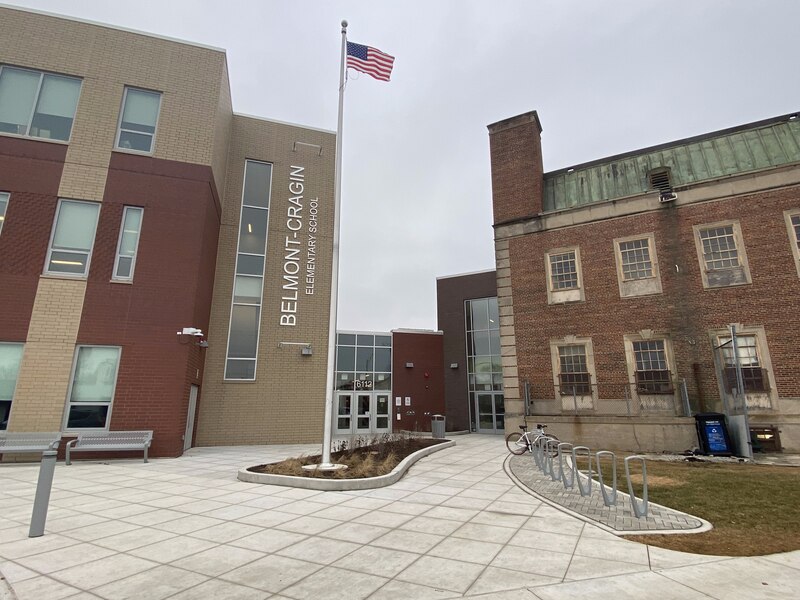
Lightfoot harnessed city funding for school projects, but focused spending on fixing up existing facilities, repairing aging roofs, and boilers.
“We’re picking off these projects that are long overdue all over the city,” Lightfoot said. “Chicago Public Schools CEO Pedro Martinez is very committed to making sure that we really invest in the infrastructure, not just band aids and trying to patch things up.”
Waguespack, who is also chairman of the City Council’s powerful Committee on Finance, said the mayor wanted to focus more money from special taxing districts known as tax-increment-financing — or TIF — districts on public schools and public parks.
A Chalkbeat analysis of finance committee records shows roughly $215.8 million in TIF money was allocated to school construction projects between when Lightfoot took office in May 2019 and today. Roughly $128.5 million was allocated between May 2015 and May 2019. Many of the projects tackled in the past four years were for long-deferred maintenance, not new construction.
In response to a Chalkbeat Chicago candidate questionnaire, Lightfoot also touted “$600 million in investments for facility improvements at neighborhood schools” in Chicago Public Schools’ 2023 budget.
A review of Chicago Public Schools’ capital plan does show larger portions of the district’s construction budget coming from “outside funding sources,” which is primarily city TIF money and state grants. However, the capital budget has declined in the last four years.
Years ago, community advocates fought to have more say over school construction decisions in Chicago, even passing a state law that created a now-dormant task force to oversee and guide school facilities planning. The city is currently under moratorium on closing schools, which will lift in 2025.
Disagreements over school construction projects have heated up recently around a plan supported by Lightfoot to build a $150 million new high school on the Near South Side, even as the district continues to lose enrollment and grapple with severely underenrolled high schools, including those that currently serve students in the area and sit just south of the site where the new school is to be built.
In an interview with Chalkbeat Chicago, Lightfoot said she sees investments in school facilities as investments in the city as a whole.
“They’ve got to be done in coordination,” Lightfoot said of the city and the school district. “They’ve got to work hand in glove and that’s really what we’ve been trying to do.”
Clashes with the Chicago Teachers Union disrupt learning
By now, it’s no secret: the mayor and the Chicago Teachers Union are anything but allies. From an 11-day teachers strike in 2019 and a delayed return to schools amid the COVID-19 pandemic in 2021 to five days of canceled classes at the height of the omicron surge in 2022, the relationship has been on a tightrope made worse with every labor strife and a war of words.
Robert Bruno, a labor education professor at University of Illinois, described Lightfoot and CTU’s relationship as “very, very hostile,” and “difficult and strained.”
The deep level of distrust between the mayor and the teachers union is not without consequences.
The fraught relationship between Lightfoot and the union may even have complicated the district’s response to COVID and the return to in-person learning.
Chicago students stayed with remote learning longer than many other cities and states. Data released last fall showed the city’s math and reading scores on the “Nation’s Report Card” fell to what they were about a decade ago.
At the time, Lightfoot argued that a return to in-person learning would curb the adverse impact of remote learning, but the union said remote learning would protect students, their families, and teachers from severe illness and death. The push to return, the union argued, was tied to pressure from the business community.
Bruno said the mayor views the teachers union as a political body with the goal of undermining her leadership, and the union believes she’s “too beholden to corporate interest and not someone who has the best interest” of the school district’s large low-income working class and multi-ethnic population.
But the mayor’s difficult relationship with the teachers union pre-dates the pandemic. The CTU supported Lightfoot’s opponent in 2019 and when she stepped into office in May 2019, the political newcomer fresh off a landslide victory found herself in contract negotiations that dramatically fizzled out, leading to an 11-day strike in October.
Despite the acrimony, the teachers union secured $1.5 billion worth of concessions from the Lightfoot administration in a five-year contract that included raises for educators and support staff, hundreds of new staff positions, and $35 million annually to help reduce overcrowding in some schools.
Five months later, the COVID-19 pandemic shut down schools once again. Students didn’t return in-person until a year later — after an impasse over safety protocols, a threat to lock out teachers from remote platforms, and finally an agreement that made way for a hybrid model with staggered reopening starting in March 2021. But the following school year was again disrupted after holiday break, leaving parents frustrated and teachers feeling deflated.
These four years are going to be remembered as “dysfunctional,” Bruno said. “She obviously has to take some responsibility for that.”
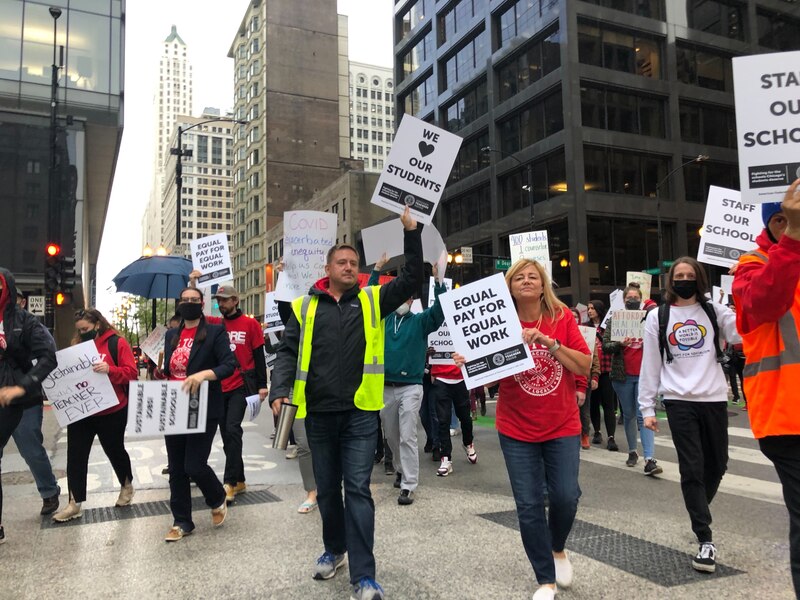
Moving forward the person who wins the mayoral election will need “to pick up the pieces of that relationship” with the union, Bruno said.
Turning things around would not be unprecedented. Rahm Emanuel famously clashed with the teachers union early in his first term, prompting the first strike in 25 years. He reportedly used an expletive in a meeting with former CTU President Karen Lewis. But years later, she admitted their tensions had softened. After Lewis died, Emanuel told the Sun-Times that the two had even attended the ballet together.
Responding to the Chalkbeat candidate questionnaire regarding the acrimonious relationship and upcoming contract negotiations, Lightfoot wrote that regardless of their “previous differences,” her team was committed to ensuring Chicago teachers were among the “best compensated in the nation and have the resources and support they need to educate the next generation of Chicagoans.”
“Our children deserve no less,” she wrote.
Lightfoot changes tune on elected school board
While campaigning for mayor in 2019, Lightfoot supported a fully elected school board, saying parents deserved a seat at the table. Elected members should be parents with “skin in the game,” she told WBEZ at the time, and suggested requirements such as first serving on local school councils.
Lightfoot’s first appointees included a group with deep experience in education, including parents who previously served on local school councils, teachers, principals, and community advocates — a departure from her predecessors whose selections were often described as a “rubber stamp” by critics.
Lightfoot told WBEZ in 2019 there would need to be thoughtful discussions on the number of board members, criteria, and how elections for these seats were financed.
But Lightfoot’s support for a fully elected school board dwindled and she instead called for a hybrid model. As legislation moved through Springfield, the mayor criticized the bill, arguing that special interests would pour millions of dollars into the races as had happened in Los Angeles.
She also criticized the 21-seat board as a “recipe for disaster.” Nevertheless, Gov. J.B. Pritzker signed the approved bill in June 2021, setting the stage for a phased-in elected school board starting in 2025. Next year, the mayor will appoint 11 seats and 10 will be elected. Another election, in 2026, would elect the 11 appointed seats, resulting in a fully elected board by 2027.
Responding to a Chalkbeat election questionnaire, Lightfoot vowed to work with Pritzker to improve the existing law to “establish clarity and ensure that our schools, teachers, and students receive the representation and resources they deserve.” She added that non-citizens, in particular, should be allowed to serve on the school board.
“Non-citizens are a significant part of CPS communities as parents, Local School Council members, and elsewhere,” Lightfoot said. “In a welcoming city, it is unconscionable that Springfield banned non-citizens from serving on the elected school board.”
Her office has created a team focused on education and human services that will work in partnership with the new school board on shared priorities, she said.
The mayor’s record on education will be an important marker in this election, Bruno said.
“As long as mayors have control over the city schools,” he said, “then it’s going to be a big determinant, I think, of how people judge their record while in office.”
Mauricio Peña is a reporter for Chalkbeat Chicago covering K-12 schools. Contact Mauricio at mpena@chalkbeat.org.
Becky Vevea is the bureau chief for Chalkbeat Chicago. Contact Becky at bvevea@chalkbeat.org.

